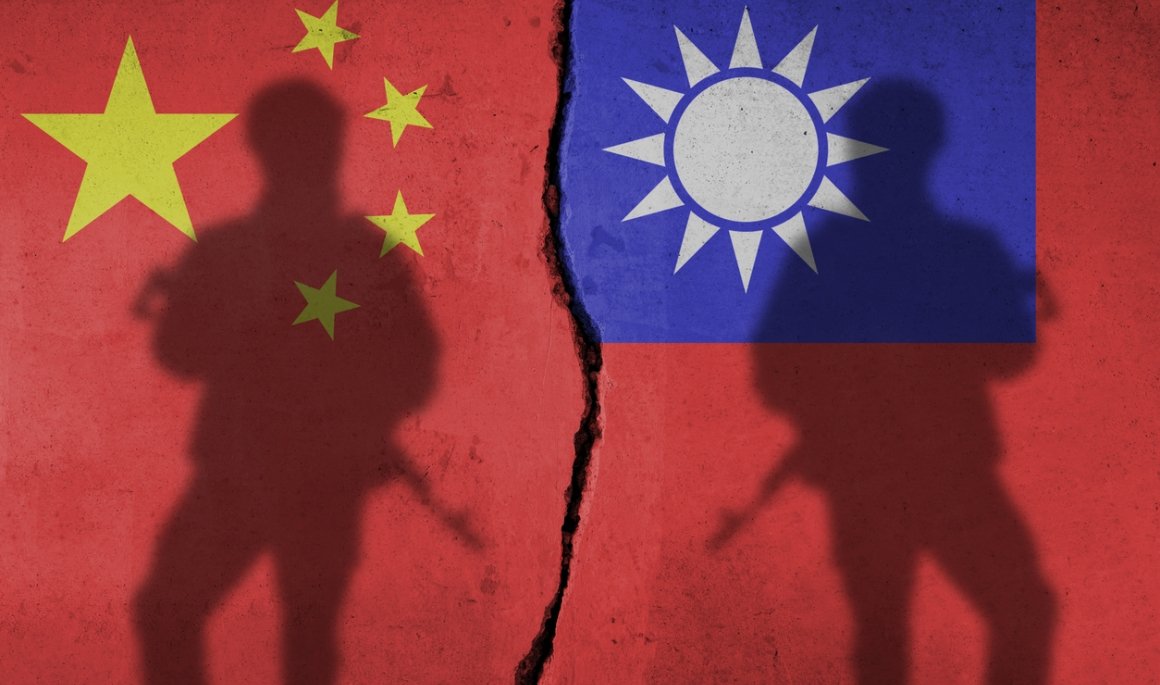Chinese Military Strategists Study the Pacific War to Enhance Amphibious Warfare Capabilities
Disclaimer: These opinion pieces represent the authors’ personal views, and do not necessarily reflect the official policies or positions of Norwich University or PAWC.

Many global strategists are concerned that China might strike against Taiwan in the coming years. Beijing may seek to bring the island under its full control in a similar fashion to the way it has acted to strictly limit Hong Kong’s autonomy over the last few years. Whether this could occur through political pressure, military intimidation, a blockade, or even an all-out invasion is a matter of intense analytical debate among experts. While still a low probability, thankfully, the latter option of an amphibious invasion still merits close scrutiny since the risks for global stability and of catastrophic destruction are immense.
In January 2023, a leading Washington DC think tank, the Center for Strategic and International Studies (CSIS), published a significant report that may represent the deepest probing to date of what a Chinese amphibious invasion of Taiwan might look like and how Taiwan acting with the U.S. could try to defeat it.1 Notably, this report reached back to the historical analogy of the famous WWII-era Normandy invasion in order to try to grasp the full scope of just how enormous an effort that a Chinese invasion of Taiwan would be. That study concludes that the Chinese People’s Liberation Army (PLA) “capabilities are much less than Allied capabilities on D-day.”2
That conclusion could be misleading, however. The Allies were fighting on many fronts, and most of the supplies had to come across the Atlantic. Planning and preparation for Normandy occurred very rapidly – over the course of about two years. By contrast, the PLA has been preparing to invade Taiwan for decades and China can devote nearly all its military resources to the effort. In a specific example of a possible miscalculation, the very comprehensive CSIS study makes the error of only counting China’s relatively few purpose-built amphibious attack ships – fewer than 1003 -- whereas the true size of the invasion armada could, in fact, amount to many thousands of ships. China possesses enormous civilian maritime resources, including the world’s largest merchant marine, coast guard, and fishing fleets. As one very experienced, retired intelligence officer argues: “…the PLA plans to rely heavily on mobilized maritime militia forces operating requisitioned civilian shipping as the logistical backbone of a cross-strait landing operation.”4
Actually, the PLA has made exhaustive studies of the D-day invasion, but Chinese strategists are also looking carefully at the bloody island campaigns of the Pacific War between the U.S. and Japan to discover more insights about amphibious warfare.5 Notably, it seems the Chinese are not just interested in U.S. amphibious operations, but also in the Japanese rampage across the Pacific in late 1941 and early 1942. This could be predicted, given the Japanese approach to amphibious warfare that stressed air superiority and the element of surprise. A recent textbook on military combined operations observes: “Whereas Germans [prioritized] mechanized warfare, the Japanese concentrated on units on foot. In part due to the lightness of their supply ‘tail,’ these were fast moving … [and] effective amphibious assaults.”6
In examining Japanese amphibious attacks, the Chinese strategists note the rather remarkable Japanese record of achieving success in 29 out of 30 amphibious operations.7 According to this analysis, these operations were successful because of Japan’s “complete preparation and thorough planning” [准备充分, 计划周密]. It is observed in this Chinese analysis that the Japanese lighter, more risk-acceptant approach to amphibious operations went against the prevailing ideas of the day that considered such operations to be “difficult.”8 Along the same lines, Japanese forces would often “forgo any fire preparation” so they could “undertake a surprise landing with lightning speed.” [迅雷不及掩耳之势奇袭登陆]9
Among the island campaigns of the bloody Pacific War, Chinese strategists quite rightly focus on Guadalcanal as a determinate battle. A recent Chinese Navy study of that battle faults Japanese decision-making hindered by poor intelligence and a debilitating cult of the offensive. In the Solomon Islands, the Japanese lacked the consistent air cover they had enjoyed in earlier island fighting, according to this analysis, noting the early loss of the critical Henderson Field to the Americans.10 Another weakness of Japanese forces on Guadalcanal concerns logistics, and this Chinese analysis faults the Japanese command for not attacking U.S. rear logistics areas. [未攻击美 方后勤补给物资]. Notably, the Chinese Navy assessment also sharply criticizes the Japanese “bushido spirit” [武士道精神] or warrior ethos that prompted unwise attacks with inadequate fire support.11 Another Chinese appraisal of the Solomons Campaign underlines the Japanese weakness in civilian shipping and the failure of its convoy system.12
Of course, the U.S. “island hopping” amphibious campaign really got underway in 1943 with the Gilbert Islands campaign. Chinese strategists have examined the extremely difficult and costly U.S. attack on Tarawa, noting that the attack had difficulties, because of “seriously inadequate preparation” [严重缺乏准备].13 That piece identified particular problems with the employment of American assault vehicles in the Tarawa landing.14 A further Chinese-language study of the Makin Island attack not long afterwards illustrates much better U.S. coordination between infantry and tanks in seizing the island.15
Some of the most difficult amphibious battles of the war occurred near the end of the war with the U.S. assaults against Iwo Jima and Okinawa in 1945. These battles, too, are being probed for lessons by Chinese researchers, naturally enough. A study of the operations of a tank landing ship (LST) during the battle of Iwo Jima notes the immense difficulties of off-loading equipment under fire, and the extraordinary challenge of treating the wounded in such a mass casualty event.16 That study also notes that despite presenting a “big and slow target” [大而慢的目标] that LST proved surprisingly durable and only a few dozen were actually sunk in combat during the Pacific War.17 Nevertheless, these Chinese analyses are fully cognizant that amphibious operations involve high casualties. Thus, a discussion of the U.S. invasion of Okinawa observes that the Americans lost 30 ships with more than 300 suffering damage.18 Another Chinese description of the Okinawa battle also noted the very heavy American losses and the necessity for “coordinated tactics employing flamethrowers and satchel charges” [喷火武器配合炸药包的战术] in order to dislodge the heavily dug-in Japanese positions.19
Returning full circle to the comprehensive new CSIS study of a hypothetical Chinese amphibious campaign to conquer Taiwan, it’s interesting to note that the authors advise the Taiwan armed forces to take a page from Japan’s bloody defense of both Iwo Jima and also Okinawa. They argue based on these battles that defending on the beach is simply not feasible, but rather forcing “the invader to take heavy casualties by attacking prepared fortifications inland” is the preferred strategy for defense of the island.20 Moreover, these authors contend that Taiwan should prepare to defend its “cities and urban sprawl,” noting that this would result in “severe damage,” but it is the best hope to prolong the conflict and cause maximum attrition for the attackers.21
Reflecting on these recommendations, one wonders if Taiwan, as a society, has truly grappled with such dilemmas and the destruction that might ensue.22 Then, there is of course the additional and more fundamental problem that the Chinese invaders in this case might share the same sanguinary determination and firepower advantage that the U.S. forces possessed in assaulting both Iwo Jima and Okinawa.23
Citations
[1] Mark F. Cancian, Matthew Cancian, and Eric Heginbotham, The First Battle of the Next War: Wargaming a Chinese Invasion of Taiwan (Washington DC: Center for Strategic and International Studies, Jan 2023).
[2] Ibid, p. 109.
[3] Ibid.
[4] Lonnie D. Henley, “Civilian Shipping and Maritime Militia: The Logistics Backbone of a Taiwan Invasion,” Chinese Maritime Report No. 21 (Newport, RI: U.S. Naval War College China Maritime Studies Institute, May 2022), p. 3.
[5] See, for example, Peng Xunhou (彭训厚) “An Unprecedented Large-scale Landing Campaign: Comment on the Landing in Normandy,” (史无前例的大规模登陆战役 – 诺曼底登陆战役述评) Military History (军事历史), no. 1.(2008), pp 28–34 and other studies cited in Lyle Goldstein, “The Hard School of Amphibious Warfare: Examining
the Lessons of the 20th Century’s Major Amphibious Campaigns for Contemporary Chinese Strategy,” Asian Security 19 (Dec 2022), no. 1, pp. 26-42.
[6] Jeremy Black, Combined Operations: A Global History of Amphibious and Airborne Warfare (London: Rowman and Littlefield, 2018), p. 150.
[7] Lu Xianchen [吕贤臣] “Maritime Strategy of the Pacific War (first segment),” [太平洋战场的海上战略 (上)] Modern Ships [现代舰船], no. 21/22 (2020), p. 153.
[8] Ibid, p. 152.
[9] Ibid, p. 153.
[10] Guo Yuanfei, Bai Wenjie, and Chi Luoming [郭渊斐,白文杰,赤骆铭] “Looking Back on the Guadalcanal Island Campaign: The Decisive US-Japan Contest to Safeguard Logistics,” [回顾瓜岛战役: 决定胜负的美日后勤保障较量] Navy Today [当代海军] (August 2020), pp. 72–74.
[11] Ibid, p. 73.
[12] Sun Xiaoxiang [孙晓翔] “Reflections on Japan’s Pacific War Strategy,” [日本太平洋战争战略之反思] Modern Ships [现代舰船] no. 3B (2015), pp. 84–85.
[13] Sun Xiaoxiang [孙晓翔] “Pacific Tide: The Route of the Counteroffensive of the U.S. Navy in 1943–45,” [太平洋 浪潮美国海军的反政之路 1943–45] Shipborne Weapons [舰载武器] (July 2020), 89.
[14] Ibid, p. 89.
[15] “Coordinating Infantry and Armor to Seize the Island: Recalling the US Army’s 193rd Tank Battalion in the Battle for Makin Island during WW2,” [步坦协同抢滩夺岛: 二战美国陆军第 193 坦克营马金战记] Weapon [兵器] no. 263 (April, 2021): 28–35.
[16] A Liaosha [阿廖沙] “Those Who Have Experienced a Crisis: With a Tank Landing Ship at the Battle of Iwo Jima” [危境亲历者: 一艘坦克登陆舰的硫磺岛之战] Shipborne Weapons [舰载武器] (Dec 2022), p.94.
[17] Ibid, p. 96.
[18] Lu Xianchen [吕贤臣] “Maritime Strategy of the Pacific War (third segment),” [太平洋战场的海上战略 (下)] Modern Ships [现代舰船], no. 1 (2021), p. 148.
[19] Liu Xiaohu [刘啸虎] “From New York to Okinawa – Memories of an American Soldier in the Pacific War” [从纽约到冲绳 一名美军士兵的太平战争回忆] Ordnance Technology [兵工科技] 2023 (13), pp. 121-22.
[20] Cancian, Cancian, and Heginbotham, “The First Battle of the Next War…,” p. 109.
[21] Ibid, p. 123.
[22] Natalie Tso, “Taiwan's Civilian Soldiers, Watching Ukraine, Worry They Aren't Prepared to Defend Their Island,” Time, March 18, 2022, https://time.com/6158550/taiwan-military-china-ukraine/.
[23] See, for example, Jeff Schogol, “Chinese Troops Vow They Are Willing to Die in Fight for Taiwan,” Task and Purpose, August 8, 2023, https://taskandpurpose.com/news/china-military-documentary-taiwan-invasion/.
About the Author
Lyle J. Goldstein, PhD is senior fellow at the Peace and War Center of Norwich University. He simultaneously serves as Director for Asia Engagement at Defense Priorities, a Washington DC think tank, and as Visiting Professor at the Watson Institute of Public and International Affairs at Brown University. From 2001-21, he served on the faculty of the U.S. Naval War College (NWC) and during that time received the Superior Civilian Service Medal for his work in establishing a leading China research center at NWC. He speaks both Chinese and Russian fluently and regularly tweets on security affairs @lylegoldstein.
Sponsored by the John and Mary Frances Patton Peace & War Center of Norwich University, VPW features subject matter experts and students who present their opinions and arguments on critical issues related to peace and war in the international community. We hope that a chorus of small voices in this forum will help illuminate a world filled with a variety of complex challenges.
Read More

From Continental Shelves to Cruise Missiles: Strategic Rivalries in the Arctic
Disclaimer: These opinion pieces represent the authors’ personal views, and do not necessarily reflect the official policies or positions of Norwich University or PAWC.

A Tale of Two Pivots: Nixon, Obama and Beijing
Disclaimer: These opinion pieces represent the authors’ personal views, and do not necessarily reflect the official policies or positions of Norwich University or PAWC.

Iran, Israel, and Hamas Conflict
Disclaimer: These opinion pieces represent the authors’ personal views, and do not necessarily reflect the official policies or positions of Norwich University or PAWC.
